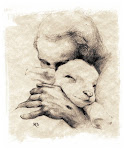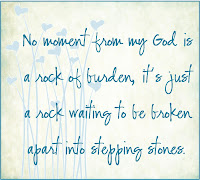Thursday's Therapy
How Do We Best Cope
with
Severe Loss and Trauma?
(Part Four)
~With Dr. Mary Baures
From A REVIEW OF THE LITERATURE ON TRAUMA AND RECOVERY
By Dr. Mary Baures, Co-Producer and Author of Undaunted Spirits
Continued from last Thursday, the following are the next three Coping Behaviors and Attitudes that Dr. Baures says Help Us Come Back from Profound Loss:
7. Broaden Your Point of View
The ability to take in and balance different points of view both between the self and others and between different parts of the self enable us to be more intimate with the self and others.
The survivors' ability to take in new perspectives on themselves seems central to how they transformed in a positive way rather than becoming stuck the way so many trauma victims do.
Max Cleland is a good example of someone who developed by interacting with the world. When he attended his first party as a triple amputee, he believed that his disability would cut him off from other people, but he discovered that when someone has been obviously hurt, other people disclose things they would not normally talk about. Later, when he was trying to become a success in politics he walked around on artificial legs, although the effort was exhausting. When he was struggling up the steps to a victory party, the wife of a mayor stopped him and asked why he was using the artificial legs: people, she said, loved him just the way he was. He was able to take in her comments and realized that he needed to accept and love himself the way he was, too.
TV producer Alan Langer, who is disabled from multiple sclerosis, says he had two choices. He could either have done the most with what he had, or he could have made himself unhappy because life did not turn out the way he thought it ought to. "When it rains out, you can either enjoy it or curse it… I know that no matter how bad it gets, there's always something I can do. It's how you hold the life you have… if you let circumstances affect you, it's your choice."
8. Letting Go of Bitterness and Hate
Allowing oneself to feel the fury of hate, especially when one has been abused by another person, is often a healthy part of the recovery process, but it is only healthy if one can also learn to let it go. Hate minimizes a victim's feelings of powerlessness and self-blame.
But after anger has been experienced, when self-compassion replaces self-blame, and when the terror of the traumatic experience is no longer too intrusive, it is necessary for survivors to let go of hate to give them vitality and hope.
Victims of abuse frequently blame themselves and lose self-esteem. Feeling anger toward the perpetrator may be the only resource available that allows personal respect to be maintained. Robert Lifton (1988) suggests that the survivor's anger is an alternative to living in the "realm of the annihilated." Anger, according to Lifton, may be a psychic lifeline when the individual is surrounded by images of death.
We hate in response to an injury that causes deep suffering or threatens life, but the wish to kill or injure the perpetrator can be self-destructive. As James Chu (1987) writes, "to have allowed the victimization in the first place, 'counter-dehumanization' is not a psychological victory" (Davenport, 1991).
9. Rage and Revenge Fantasies
Judith Herman (1992), who works with trauma victims, suggests that the revenge fantasy frequently gives the roles of victim and abuser the same frozen, wordless quality as that of the traumatic memory. The victim longs to rid her or his self of terror and shame by retaliating. The desire for revenge emerges from the feeling of helplessness and is an attempt to restore a feeling of power. Although the victim imagines that revenge will bring relief, the opposite is true. Repetitive revenge fantasies actually increase the victim's torment; intrusive images can be as frightening as the trauma itself. They can never compensate for the harm that was done; more likely, they make the survivor feel like a monster. Those who actually succeed in revenge suffer intractable disturbances (Herman, 1992).
In her work with women who were raped, Herman found that survivors must come to terms with their wishes for revenge. As anger eventually is channeled into righteous indignation, the survivor can become free of the revenge fantasy and transform it into legal action. As she suggests,
"(G)enuine contrition in a perpetrator [of violence] is a rare miracle. Fortunately, the survivor does not need to wait for it. Her healing depends on the discovery of restorative love in her own life; it does not require that this love be extended to the perpetrator."
Revenge never evens the score or creates fairness because it entails an escalation of pain and a cycle of hatred. As Levin (1992), who studied conflict resolutions, maintains, "justice" does not always solve problems. She illustrates her argument by quoting Ghandi:
"If we all live by an eye for an eye, the whole world would be blind."
Learning to forgive seems to play a central role in recovering from trauma, not least of all because revenge fantasies, which focus most of one's energy on the wish to hurt another, leave little room for positive actions.
~To be continued next week...












































1 comment:
Post a Comment